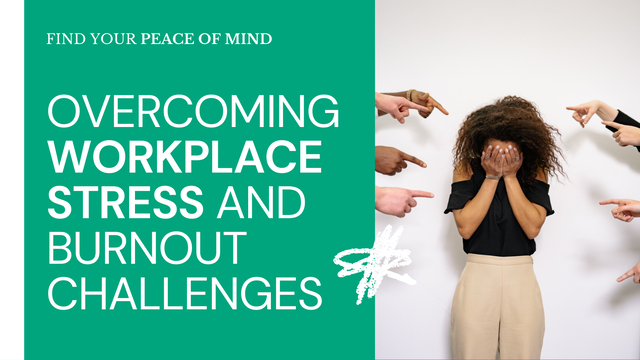Navigating Workplace Stress: Employee Well-Being Strategies
2023-10-15
Stress management is a tailored suit, designed to fit the unique contours of employee work life. From identifying the culprits behind your stress to actionable strategies for a healthier work environment, this piece covers it.
It's past time to confront the upsetting fact that work-related stress exists. We're not referring to the occasional deadline stress; more so, we mean the unrelenting anxiety that depletes your inner peace. the kind that stalks you at home, messes with your sleep, and at times disturbs your time enjoying Netflix.
The biggest shocker, though, is the realization that things don't have to be this way.
From identifying the culprits behind your stress to actionable strategies for a healthier work environment, this piece covers it.
Now, let's turn the page and start this path towards a stress-free work life.
What Causes Stress in the Workplace?
Stress in the workplace is a common phenomenon, but what triggers it? Here are some key factors:
- Deadlines: The ticking clock can be your worst enemy.
- Workload: Too much or too little, both can be stressful.
- Management: Lack of support can leave you feeling isolated.
- Work-Life Balance: When work seeps into personal time.
- Job Security: The looming fear of layoffs.
- Interpersonal Relations: Office politics or conflicts with colleagues.
Each of these factors can contribute to a stressful environment. It's not just about the job itself, but the conditions surrounding it.
How Does Workplace Stress Affect Employee Wellbeing?
Workplace stress doesn't just stay in the office; it follows you home. Here's how:
- Physical Health: Stress can manifest as headaches, sleep disorders, and even cardiovascular issues.
- Mental Health: Anxiety and depression rates skyrocket with increased stress.
- Productivity: Stress hampers your ability to focus and deliver.
- Relationships: Stress at work can strain personal relationships.
- Job Satisfaction: High stress often leads to job dissatisfaction, making the workplace a dreaded space.
The ripple effects of workplace stress are far-reaching, affecting all aspects of life.
Why is it Important to Manage Stress in the Workplace?
Managing stress isn't just an individual responsibility; it's a business imperative. Here's why:
- Employee Retention: Happy employees stick around.
- Productivity: Lower stress levels lead to higher productivity.
- Company Culture: A stress-free environment fosters collaboration and innovation. It's an essential step to promoting a people-first culture.
- Healthcare Costs: Reduced stress equals fewer sick days and lower healthcare costs.
- Reputation: Companies that care for their employees attract top talent.
In short, managing stress is not just good for you; it's good for business.
Which Strategies Help Employees Adjust to the Stress at Work?
Now, what can you actually do about stress at work? The following strategies are more than just band-aids on a wound; they're foundational shifts designed to transform your work environment.
Allow Employees to Set Their Own Schedules Within Reason
Allowing employees to set their own schedules offers the freedom to balance work and personal commitments, leading to increased job satisfaction and productivity. This approach respects individual work styles and life needs, making the workplace a less stressful environment.
- Core Hours: Establish a set of core hours for meetings and collaborations.
- Remote Work: Offer the option to work from home when feasible.
- Time Blocks: Encourage setting aside specific time blocks for focused work.
Offer Paid Mental Health Days Separate from Sick Leave
Mental health is just as crucial as physical health. Offering paid mental health days separate from regular sick leave can be a breath of fresh air for stressed employees. It provides mindful retreats to unplug, recharge, and come back stronger. This not only boosts employee engagement but also sends a strong message that the company values mental well-being.
- No Questions Asked: Make the process stigma-free.
- Resource List: Provide a list of mental health resources or activities.
- Follow-Up: Ensure a smooth transition back to work.
Provide Free, Confidential Counseling Services at the Workplace
Sometimes, talking it out helps. Offering free, confidential counseling services at the workplace can be a significant stress reliever. Employees can discuss their concerns without the fear of judgment, knowing that the conversation stays within those four walls.
- On-Site Counselors: Have professionals available during work hours.
- Online Sessions: For those who prefer digital communication.
- Anonymity: Ensure that the service is confidential and anonymous.
Invest in Ergonomic Furniture to Reduce Physical Stress
Your chair and desk are more than just furniture; they're your daily companions. Investing in ergonomic furniture can greatly lessen physical stress, leading to a more comfortable and productive work environment.
- Adjustable Chairs: For better posture and reduced back pain.
- Standing Desks: To break the monotony of sitting all day.
- Foot Rests: For better leg and lower back support.
Provide Healthy Snacks and Organize Nutrition Seminars
When it comes to stress, especially, you are what you consume. Employees can learn the value of a balanced diet by attending nutrition seminars and receiving nutritious snacks, which will positively impact their stress levels and general well-being.
- Fruit Baskets: A simple yet effective start.
- Nutrition Talks: Invite experts to discuss diet and stress.
- Recipe Swaps: Encourage sharing of healthy recipes among employees.
Offer Gym Memberships or Fitness Class Reimbursements
Physical activity is a proven stress buster. Offering gym memberships or fitness class reimbursements can motivate employees to take that extra step towards a healthier lifestyle.
- Gym Partnerships: Collaborate with local gyms for discounted rates.
- In-House Classes: Yoga or Zumba sessions during lunch breaks.
- Fitness Challenges: Create monthly challenges to keep the momentum going.
Organize Regular Team Outings or In-Office Games
All work and no play makes for a stressful day. Regular team outings or in-office games can be a great way to break the routine and foster a sense of community, significantly boosting employee engagement and reducing stress.
- Monthly Outings: Plan a day out every month.
- Game Room: A dedicated space for games and relaxation.
- Team Challenges: Foster teamwork through fun competitions.
Conclusion
Stress management isn't a one-size-fits-all caper; it's a tailored suit, designed to fit the unique contours of employee work life. The strategies we've discussed are more than just words on a screen; they're actionable steps to make the workplace a sanctuary where productivity thrives and stress takes a backseat.
Implementing these strategies is a long-term investment in well-being and career. While stress might be an inevitable part of life, it doesn't have to define work experience.
So, why wait? Begin working your way to a stress-free workplace today, and observe how it changes settings in the workplace as well as at home.
Written by Austin Page
Did you find this helpful? Lets us know! Send your questions and comments to [email protected]
See More Posts
10 Ways People Can Use Their Extra Day Off with a Four-Day Workweek to Boost Well-being
Discover how a four-day workweek can improve employee well-being, work-life balance, and workplace culture. Check out these 10 ways professionals can use their extra day off to boost personal growth and enhance their lives.
Platform
Features
Platform
Features
Tap My Back @2024. All rights reserved.





